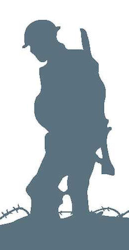Name
Herbert Robert Higgins
Conflict
First World War
Date of Death / Age
Rank, Service Number & Service Details
Australian Imperial Force
24th Infantry Battalion
Awards: Service Medals/Honour Awards
Not Yet Researched
Cemetery/Memorial: Name/Reference/Country
Headstone Inscription
Not Researched
UK & Other Memorials
Biography
Herbert Higgins was born in the spring of 1896 at Abbots Langley. He was the youngest of four sons and one daughter born to George and Amy Higgins. Georger Higgins worked as a House Painter and the family lived at Bedmond Hill, Bedmond. In the 1911 Census Herbert was recorded working as a Junior Clerk. At some point before 1915 he emigrated to Australia and on 24th March 1915 joined up with the Australian Imperial Force (AIF). He gave his occupation as a Carpenter.
Herbert was appointed to C Company of the 24th Infantry Battalion on 29th April 1915, and left Australia on 8th May 1915. The 24th Battalion served in Gallipoli, in the Lone Pine Sector, between 4th September and 19th December 1915. On 25th September Herbert was admitted to the 6th Field Hospital at ANZAC Beach suffering from influenza. He returned to duty on 29th September, and on 2nd December was appointed Temporary Corporal.
Herbert was recorded for the first time in the Abbots Langley Parish Magazine Roll of Honour in December 1915, serving with the Australian Imperial Force.
He travelled from Gallipoli to Egypt and on 11th January 1916 was promoted to the rank of Corporal, whilst based in the Suez Canal Zone. In March 1916 the 24th Battalion was transferred to the Western Front. On 22nd August 1916 Herbert was wounded at Mouquet Farm on the Somme and was admitted to hospital with a gun-shot wound to his arm. He recovered and re-joined his unit on 24th August and later served at the Battle of Pozieres.
On 4th January 1917 the 24th Battalion returned to England. Herbert was detached to join the 6th Training Battalion at Larkhill. His Service Record indicated that he was promoted as Temporary Sergeant when Sergeant Stewart was evacuated, and he returned to France from Folkestone on 6th August 1917. He re-joined the 24th Infantry Battalion on 12th August. When Sergeant Stewart returned to duty on 11th September Herbert reverted to the rank of Corporal. Sergeant Stewart was evacuated once again on 22nd September and Herbert became a Temporary Sergeant again. He was wounded again on 4th October, and admitted to 64 Field Ambulance with gun-shot wounds in his back and shoulder. Later that day he was moved to 11 Casualty Clearing Station, and reverted to the rank of Corporal. On 5th October he was transferred to No 26 General Hospital at Etaples, and on 11th October was evacuated to England, where he was admitted to the 2nd Royal Military Hospital at, Canterbury on 12th October. He was transferred to No 3 Auxiliary Hospital at Dartford on 15th October before being discharged to Weymouth Depot on 17th October 1917. On 19th December Herbert returned to France, travelling from Southampton to Le Harve, and re-joined the 24th Infantry Battalion in the Field on 26th December.
When Sergeant Stewart was evacuated again Herbert was promoted to Sergeant on 5th August 1918, and was then wounded in action on 2nd September with a gun-shot wound to the left thigh. He was admitted to the 12th General Hospital at Rouen on 3rd September, and evacuated to England on 5th September, where he was admitted to 1st Southern General Hospital at Stourbridge near Birmingham on 6th September. He recovered sufficiently to go on leave from 21st October to 5th November 1918, and then spent time at Sutton Veny, near Warminster. From the time of the Armistice in November 1918 the No 1 Australian General Hospital and other rest camps were established at Sutton Veny. Herbert remained there until 28th April 1919, when he was granted leave with pay to attend a Carpentry Course at the North London Polytechnic. He married Jeannie Biggenden from Redfearn New South Wales at St Olaves Church, Stoke Newington on 16th August.
He was then granted indefinite leave and on 5th December 1919 and returned to Australia arriving on 11th January 1920. Herbert was discharged on 16th April 1920, and went on to live at Rockdale, a suburb of Sydney.
Herbert Higgins survived the War. His brother William also survived, however his other brother, Thomas, was killed on 4th November 1918, and was the last man from Abbots Langley to die in action during the War.
Acknowledgments
Roger Yapp - www.backtothefront.org



